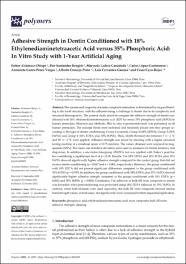Mostrar el registro sencillo del ítem
Adhesive Strength in Dentin Conditioned with 18% Ethylenediaminetetraacetic Acid versus 35% Phosphoric Acid: In Vitro Study with 1-Year Artificial Aging
| dc.contributor.author | Cayo Rojas, César Félix | |
| dc.contributor.author | Alcántara-Obispo, Esther | |
| dc.contributor.author | Santander-Rengifo, Flor | |
| dc.contributor.author | Ladera-Castañeda, Marysela | |
| dc.contributor.author | López-Gurreonero, Carlos | |
| dc.contributor.author | Castro Pérez-Vargas, Antonieta | |
| dc.contributor.author | Cornejo-Pinto, Alberto | |
| dc.contributor.author | Cervantes-Ganoza, Luis | |
| dc.date.accessioned | 2022-11-03T16:08:40Z | |
| dc.date.available | 2022-11-03T16:08:40Z | |
| dc.date.issued | 2022-10-12 | |
| dc.identifier.uri | https://hdl.handle.net/20.500.14308/4114 | |
| dc.description.abstract | The success and longevity of a resin composite restoration is determined by its good bond ing to the tooth structure, with the adhesion being a challenge to dentin due to its complexity and structural heterogeneity. The present study aimed to compare the adhesive strength of dentin con ditioned with 18% ethylenediaminetetraacetic acid (EDTA) versus 35% phosphoric acid (H3PO4) in human premolars. Materials and Methods: This in vitro experimental study was performed on 40 human premolars. The occlusal thirds were sectioned and randomly placed into four groups ac cording to the type of dentin conditioning: Group 1 (control), Group 2 (18% EDTA), Group 3 (35% H3PO4) and Group 4 (18% EDTA plus 35% H3PO4). Then, 10,000 thermocycles between 5 +/− 2 °C and 55 +/− 2 °C were applied. Adhesive strength was tested by shearing with a digital universal testing machine at a crosshead speed of 0.75 mm/min. The values obtained were analyzed in meg apascals (MPa). The mean and standard deviation were used as measures of central tendency and dispersion. In addition, a one-factor intergroup ANOVA test was applied with Tukey’s post hoc test considering a significance level of p < 0.05. Results: The 18% EDTA and 18% EDTA plus 35% H3PO4 showed significantly higher adhesive strength compared to the control group that did not receive dentin conditioning (p = 0.047 and p < 0.001, respectively). However, the group conditioned with 18% EDTA did not present significant differences compared to the group conditioned with 35% H3PO4 (p = 0.997). In addition, the group conditioned with 18% EDTA plus 35% H3PO4 showed significantly higher adhesive strength compared to the groups conditioned with 18% EDTA (p = 0.002) and 35% H3PO4 (p = 0.001). Conclusion: The adhesion of bulk fill resin composite to dentin was favorable when preconditioning was performed using 18% EDTA followed by 35% H3PO4. In contrast, when both etchants were used separately, the bulk fill resin composite showed similar bond strength values in both cases, but significantly lower compared to their sequential application. | es_PE |
| dc.format | application/pdf | es_PE |
| dc.language.iso | en | es_PE |
| dc.publisher | MDPI. Polymers | es_PE |
| dc.rights | info:eu-repo/semantics/openAccess | es_PE |
| dc.rights | Attribution-NonCommercial-NoDerivs 3.0 United States | * |
| dc.rights.uri | http://creativecommons.org/licenses/by-nc-nd/3.0/us/ | * |
| dc.source | Universidad Privada San Juan Bautista | es_PE |
| dc.source | Repositorio institucional - UPSJB | es_PE |
| dc.subject | Ácido fosfórico | es_PE |
| dc.subject | Ácido etilenodiaminotetracético | es_PE |
| dc.subject | Compuesto de resina | es_PE |
| dc.subject | Resina de relleno a granel | es_PE |
| dc.subject | Fuerza adhesiva | es_PE |
| dc.subject | Cizallamiento | es_PE |
| dc.title | Adhesive Strength in Dentin Conditioned with 18% Ethylenediaminetetraacetic Acid versus 35% Phosphoric Acid: In Vitro Study with 1-Year Artificial Aging | es_PE |
| dc.type | info:eu-repo/semantics/article | es_PE |
| dc.subject.ocde | https://purl.org/pe-repo/ocde/ford#3.02.14 | es_PE |
| dc.publisher.country | CH | es_PE |
| dc.date.embargoEnd | 2022-11-03 | |
| dc.identifier.doi | https://doi.org/10.3390/polym14204291 | es_PE |
| dc.type.version | info:eu-repo/semantics/publishedVersion | es_PE |
| upsjb.especialidad | Estomatología | es_PE |



